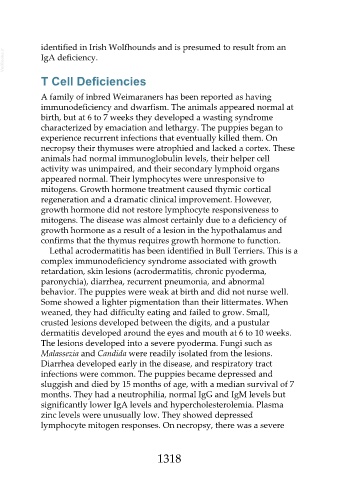Page 1318 - Veterinary Immunology, 10th Edition
P. 1318
identified in Irish Wolfhounds and is presumed to result from an
VetBooks.ir IgA deficiency.
T Cell Deficiencies
A family of inbred Weimaraners has been reported as having
immunodeficiency and dwarfism. The animals appeared normal at
birth, but at 6 to 7 weeks they developed a wasting syndrome
characterized by emaciation and lethargy. The puppies began to
experience recurrent infections that eventually killed them. On
necropsy their thymuses were atrophied and lacked a cortex. These
animals had normal immunoglobulin levels, their helper cell
activity was unimpaired, and their secondary lymphoid organs
appeared normal. Their lymphocytes were unresponsive to
mitogens. Growth hormone treatment caused thymic cortical
regeneration and a dramatic clinical improvement. However,
growth hormone did not restore lymphocyte responsiveness to
mitogens. The disease was almost certainly due to a deficiency of
growth hormone as a result of a lesion in the hypothalamus and
confirms that the thymus requires growth hormone to function.
Lethal acrodermatitis has been identified in Bull Terriers. This is a
complex immunodeficiency syndrome associated with growth
retardation, skin lesions (acrodermatitis, chronic pyoderma,
paronychia), diarrhea, recurrent pneumonia, and abnormal
behavior. The puppies were weak at birth and did not nurse well.
Some showed a lighter pigmentation than their littermates. When
weaned, they had difficulty eating and failed to grow. Small,
crusted lesions developed between the digits, and a pustular
dermatitis developed around the eyes and mouth at 6 to 10 weeks.
The lesions developed into a severe pyoderma. Fungi such as
Malassezia and Candida were readily isolated from the lesions.
Diarrhea developed early in the disease, and respiratory tract
infections were common. The puppies became depressed and
sluggish and died by 15 months of age, with a median survival of 7
months. They had a neutrophilia, normal IgG and IgM levels but
significantly lower IgA levels and hypercholesterolemia. Plasma
zinc levels were unusually low. They showed depressed
lymphocyte mitogen responses. On necropsy, there was a severe
1318

